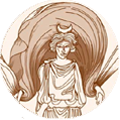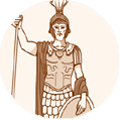The Roman trail
Roman Trail
This educational trail came into being in 2007, in co-operation with Römerkastell Saalburg and Hessische Landesarchäologie, the Hessian Institute of Archeology. It was opened by students and experts from science and politics.
The circular route runs along an antique castellum, which is situated right next to the UNESCO World Cultural Heritage ‘Limes’. So far it is the first and only offer that aims at playfully conveying knowledge in the form of an educational trail.
Here big and small visitors can gather information on the ‘Limes’, the Roman castellum und Roman life. The six stations provide games, fun and knowledge.
Expert Opinions
Professor Dr. Egon Schallmayer (Director of Roman Castellum Saalburg): ‘We have had a close relationship with the Lochmühle for a long time. Now we have been able to initiate a project together. Thus we can secure the continued existence of the World Cultural Heritage and, at the same time, let children discover the world of the Romans in a playful way.‘
Dr. Carsten Amrhein (Staff member of Roman Castellum Saalburg and the project’s curator): ‘As far as its content is concerned, the Roman trail presented a real challenge, as it was necessary to start from where the children were: in their leisure time. This also means that we had to approach the central themes of Roman culture and civilization in such a way that children can identify with those topics and every so often can relate them to their own living environment.‘
Dr. Andreas Thiel (Managing Director of Deutsche Limes Kommission): ‘This project, which has so far been unique for ‘Limes’, clearly answers the question of how the World Cultural Heritage has been accepted locally. Freizeitpark Lochmühle is an excellent example of a so-called Public Private Partnership. It also shows that the UNESCO World Cultural Heritage is nothing imposed on people, but, in fact, supported by the locals.‘
Roman Quiz
Are you interested in finding out whether you have a Roman name and how the Roman calendar works? In Roman times the seven days of the week were named after various gods. Which day is it today?
Click on the buttons and find out.
Saturn
The Roman god of sowing
German: Samstag (=Saturday) – derived from Jewish ‘Sabbat’
A temple for Saturn was built at the foot of Capitoline Hill. In his honour the festival of the Saturnalia was celebrated. The festival took place on 17th December.
The Romans had working days and holidays. They did not have a structured week with five working days and two weekend days, as we know it. Holidays were days with bad omens, religious festivals and holidays decreed by the imperator. The birthday of the imperator was celebrated in a special way. In the Roman calendar there were 176 holidays in all. This corresponds to 52 weekends off work and about 4 weeks of holidays in our modern calendar.

Sol (Invictus)
Roman sun god
German: Sonntag (=Sunday) – derived from Sonne (=sun)
A temple in Circus Maximus was dedicated to Sol. The Romans celebrated a festival in his honour every four years.
Usually places of worship were dedicated to the gods. Such places of worship could be temples, which were built on the hills of Rome. The seven Hills of Rome, which the City of Rome was situated on, are called Capitoline Hill, Esquiline Hill, Viminal Hill, Quirinal Hill, Aventine Hill and Palatine Hill.

Luna
Roman moon goddess
German: Montag (=Monday) – Moni = Germanic giant of the moon
Luna was worshipped, among other places, in a temple on Aventine Hill and in another one on the Palatine Hill.
The Romans knew working days and holidays. They did not have a structured week with five working days and two weekend days, as we know it. Holidays were days with bad omens, religious festivals and holidays decreed by the imperator. The birthday of the imperator was celebrated in a special way. In the Roman calendar there were 176 holidays in all. This corresponds to 52 weekends off work and about 4 weeks of holidays in our modern calendar.

Mars
The Roman god of war and agriculture
Italian: Martedi
Latin: Martis dies
English: Tuesday – derived from Ziu, the Teutonic god of justice
His symbols were the lance and the bull. He was presumed to be the father of Romulus and Remus, the founders of Rome. The name Marcus already existed at that time. It means “consecrated to Mars” and the month March is called after the god. Today we assume that especially boys born in March were initially called Marcus.

Jupiter
Highest Roman god
German: Donnerstag (=Thursday) – Donar/Thor = norse god of thunder
Temples on many Roman hills were dedicated to him. Among those were Esquiline Hill, Viminal Hill, Caelius Hill, Aventine Hill, Quirinal Hill. His main temple was on Capitoline Hill. The Romans celebtrated vintage festivals like the Meditrinalia (as well as others) in his honour.
Usually places of worship were dedicated to the gods. Such places of worship could be temples, which were built on the hills of Rome. The seven Hills of Rome, which the City of Rome was situated on, are called Capitoline Hill, Esquiline Hill, Viminal Hill, Quirinal Hill, Aventine Hill and Palatine Hill.

Venus
Roman goddess of love
German: Freitag (=Friday) – Freyja: Germanic mother of gods
She was worshipped in a temple near Circus Maximus and in a temple on Capitoline Hill. In her honour the festival of the ‘Veneralia’ was celebrated on 1st April every year.
The Romans had working days and holidays. They did not have a structured week with five working days and two weekend days, as we know it. Holidays were days with bad omens, religious festivals and holidays decreed by the imperator. The birthday of the imperator was celebrated in a special way. In the Roman calendar there were 176 holidays in all. This corresponds to 52 weekends off work and about 4 weeks of holidays in our modern calendar.

Mercury
Roman god of commerce
German: Mittwoch (=Wednesday) – ‘middle‘ of the week
Mercury was worshipped in a temple on Aventine Hill.
The Romans had working days and holidays. They did not have a structured week with five working days and two weekend days, as we know it. Holidays were days with bad omens, religious festivals and holidays decreed by the imperator. The birthday of the imperator was celebrated in a special way. In the Roman calendar there were 176 holidays in all. This corresponds to 52 weekends off work and about 4 weeks of holidays in our modern calendar.

Quiz
Which god is hidden behind Monday?
Luna
Which chocolate bar is named after a god?
Mars
What is the name of one of the seven hills of Rome?
Capitol, Caelius, Esquilin, Viminal, Quirinal, Aventin oder Palatin
What is the name of the highest Roman god?
Jupiter
Which day of the week is connected to the northern Teutonic god of thunder?
Donnerstag
What is the name of the Roman goddess of the moon?
Luna



